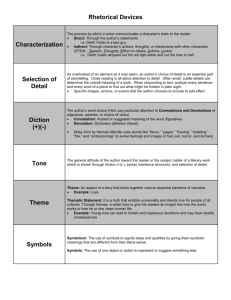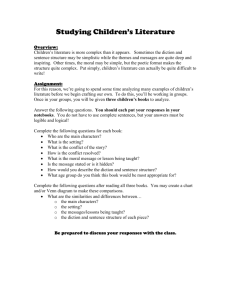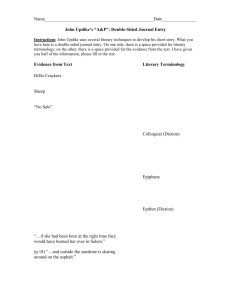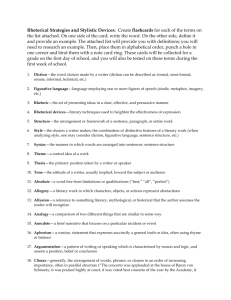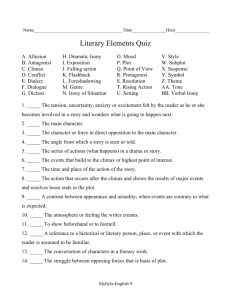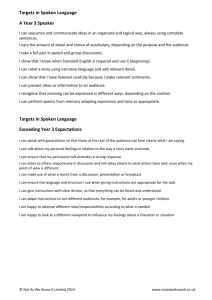English 11-12P: Literature Terms
advertisement
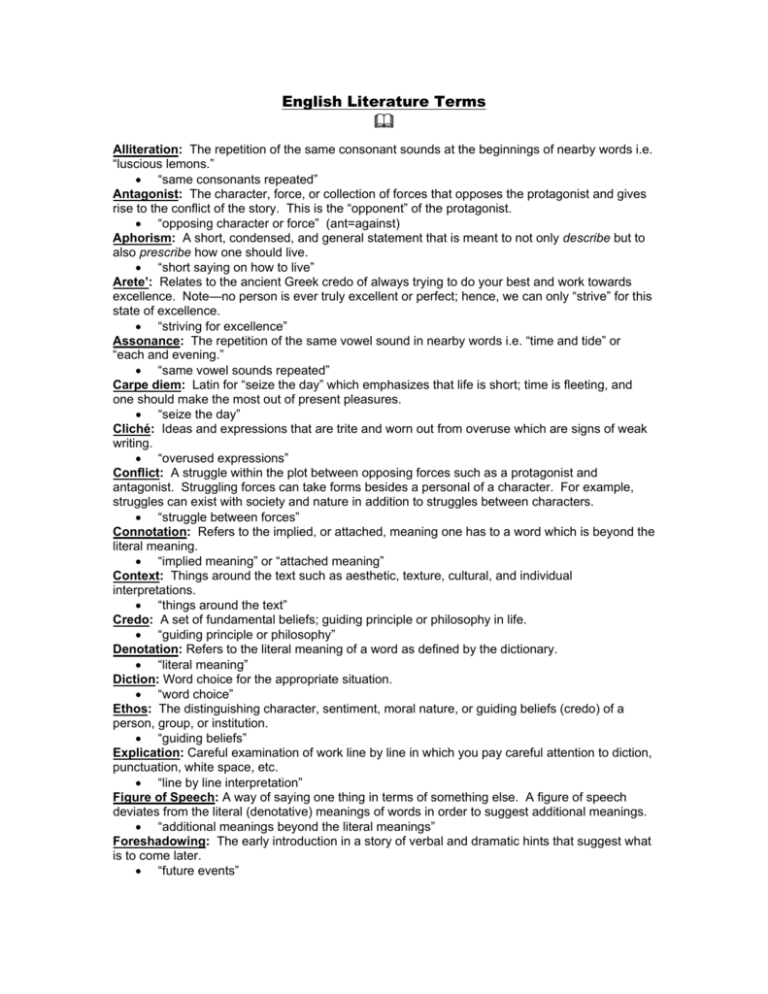
English Literature Terms Alliteration: The repetition of the same consonant sounds at the beginnings of nearby words i.e. “luscious lemons.” • “same consonants repeated” Antagonist: The character, force, or collection of forces that opposes the protagonist and gives rise to the conflict of the story. This is the “opponent” of the protagonist. • “opposing character or force” (ant=against) Aphorism: A short, condensed, and general statement that is meant to not only describe but to also prescribe how one should live. • “short saying on how to live” Arete’: Relates to the ancient Greek credo of always trying to do your best and work towards excellence. Note—no person is ever truly excellent or perfect; hence, we can only “strive” for this state of excellence. • “striving for excellence” Assonance: The repetition of the same vowel sound in nearby words i.e. “time and tide” or “each and evening.” • “same vowel sounds repeated” Carpe diem: Latin for “seize the day” which emphasizes that life is short; time is fleeting, and one should make the most out of present pleasures. • “seize the day” Cliché: Ideas and expressions that are trite and worn out from overuse which are signs of weak writing. • “overused expressions” Conflict: A struggle within the plot between opposing forces such as a protagonist and antagonist. Struggling forces can take forms besides a personal of a character. For example, struggles can exist with society and nature in addition to struggles between characters. • “struggle between forces” Connotation: Refers to the implied, or attached, meaning one has to a word which is beyond the literal meaning. • “implied meaning” or “attached meaning” Context: Things around the text such as aesthetic, texture, cultural, and individual interpretations. • “things around the text” Credo: A set of fundamental beliefs; guiding principle or philosophy in life. • “guiding principle or philosophy” Denotation: Refers to the literal meaning of a word as defined by the dictionary. • “literal meaning” Diction: Word choice for the appropriate situation. • “word choice” Ethos: The distinguishing character, sentiment, moral nature, or guiding beliefs (credo) of a person, group, or institution. • “guiding beliefs” Explication: Careful examination of work line by line in which you pay careful attention to diction, punctuation, white space, etc. • “line by line interpretation” Figure of Speech: A way of saying one thing in terms of something else. A figure of speech deviates from the literal (denotative) meanings of words in order to suggest additional meanings. • “additional meanings beyond the literal meanings” Foreshadowing: The early introduction in a story of verbal and dramatic hints that suggest what is to come later. • “future events” 2 Formal Diction: A dignified, impersonal, and elevated use of language that might be hard to understand—a very controlled language with strict syntactical form and complex words. • “elevated language” or “difficult to understand language” Gothic: The dark side of enlightenment related to the things that can’t be explained rationally through science and reason. • “dark side of enlightenment” Grammar: Study or rules of languages and the inflections between words. • “study or rules of language” Hubris: The perversion of man’s pride. • “perverted pride” or “too much pride” Hyperbole: An extreme overstatement such as “it’s raining cats and dogs.” • “overstatement” Informal Diction: A very conversational language to the point where it resembles common dialogue. If often includes: slang, contractions, and many simple or common words. • “conversational language” Irony: A literary device that uses contradictory statements or situations to reveal a reality different from what appears to be true. The gap between what is expected and what actually happens in reality. • “gap between expected and reality” Jargon: Another form of diction that is related to particular groups in which the language is defined by a trade or profession. • “technical language related to a trade or profession” Logos: Reason that in ancient Greek philosophy is the controlling principle in the universe. • “logical reason” Metaphor: A figure of speech that makes an implicit (implied) comparison between two unlike things without using the words like or as. They assert the identity of dissimilar things such as “all the world’s a stage.” • “implicit comparison of unlike things” Middle Diction: Language that is used by most of the educated people and is fairly conventional with acceptable patterns of words. • “educated language” Motif: A dominate idea, repeated design or color, or central theme. A conspicuous element such as a type of incident, device, reference, or formula which occurs frequently in works of literature i.e. the “loathly lady” who turns out to be a beautiful princess is a common motif of folklore. • “dominate or repeated idea” Objective: Governed by many people’s opinions. • “factual and rational viewpoint without personal feelings” Paraphrase: A restatement of a story’s central ideas in your own words. • “restatement of central ideas” Pathos: An emotion of sympathetic pity--suffering, experience, or emotion. • “sympathetic pity” Personification: Gives an inanimate object human-like qualities or characteristics. • “humanizes an object” Picturesque: Beautiful or striking as in a picture; strikingly graphic and vivid. • “beautiful and striking” Plot: Author’s selection and arrangement of incidents in a story. Plot shapes action and gives the story a particular focus. Plot includes not just what happens but also how and why things happen the way they do. Plot is the organizing principle that controls the order of events. • “what, how, and why things happen” Point of View: Refers to who tells us the story and what their view is of the: plot, characters, and setting. What we know and what we feel about the story are shaped by the author’s choice of point of view and their narrator’s point of view. • “shapes feelings and knowledge of story” Protagonist: The main character (or force) whom engages the reader’s interest and empathy. • “main character or force” (pro=for) 3 Satire: Exaggeration and distortion to expose life situations. Satire pokes fun at society through ridicule, exaggeration, and distortion. It also exposes vices, follies, or errors. • “exaggeration and distortion” Setting: The physical and social context in which the action of a story occurs. Major elements can be: time, place, and social environment. These frame characters and evoke moods that prepare the reader for what is about to come. • “physical and social context of story action” Simile: An explicit comparison between two things by using words such as: like, as, than, appears, and seems. • “explicit comparison between two things” Slang: Type of informal diction used in conversational language that is peculiar to a particular group. • “informal and nonstandard language” Subjective: Governed by one person’s opinion. • “personal viewpoint” Sublime: Usually refers to a state of nature that is awe inspiring through sheer terror. A state that changes ones normal perception of boundaries. There is usually a well-defined boundary that exists between the “perceived object” and the “perceived subject.” This boundary is eroded out of necessity when standing next to the sublime in nature—you are forced to interact with the overpowering force of the sublime. • “beautiful but scary” or “awe inspiring through sheer terror” Suspense: “The lack of certainty on the part of a concerned reader about what is going to happen—especially for characters with whom the reader has established a bond of sympathy. • “lack of certainty about what will happen” Symbolism: A person, object, or event that suggests more than its literal meaning. Symbolic meanings are usually embedded in the texture of a story, but they are not hidden; rather, they are carefully placed. The reader needs to carefully consider the elements of the story and use sensitivity to its language along with common sense to recognize symbolism. • “more than literal meaning” Syntax: The rules governing word order and word choice. Syntax choice can greatly alter the feeling of writing. • “rules for word order and word choice” Tone: The expression of a literary speaker’s “attitude to the reader.” Expresses a moral commentary on how the audience is supposed to feel about the action of drama. • “attitude” or “feeling” of the story Vanitas Motif: Central idea that one cannot count on anything in life as all life is in a constant state of flux and change. • “nothing stays the same” Zeitgeist: The general intellectual, moral, and cultural climate of an era. • “spirit of the day” --Supplemental Sources for Literary Terms & Quotations-A Contemporary Guide to Literary Terms by Edwin J. Barton and Glenda A. Hudson. (Houghton Mifflin Company) A Glossary Of Literary Terms by M. H. Abrams. (Harcourt Brace Publishers) A Handbook To Literature by William Harmon and C. Hugh Holman. (Prentice Hall Publishers) The International Thesaurus of Quotations Compiled by Rhoda Thomas Tripp. (Perennial Library/Harper & Row Publishers) The Little Brown Handbook by H. Ramsey Fowler and Jane E. Aaron. (Harper Collins Publishers) Æ www.ronjones.org

